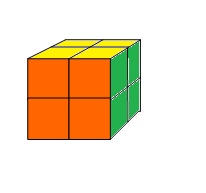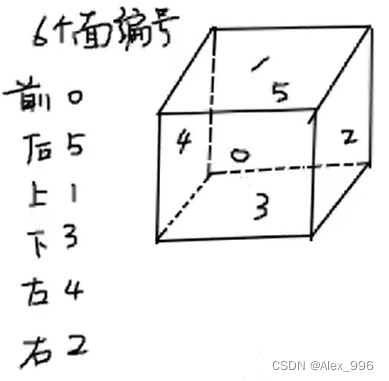2017年第八届蓝桥杯 - 省赛 - C/C++大学A组 - C. 魔方状态
魔方状态
二阶魔方就是只有2层的魔方,只由8个小块组成。

小明很淘气,他只喜欢3种颜色,所有把家里的二阶魔方重新涂了颜色,如下:
前面:橙色
右面:绿色
上面:黄色
左面:绿色
下面:橙色
后面:黄色
请你计算一下,这样的魔方被打乱后,一共有多少种不同的状态。
如果两个状态经过魔方的整体旋转后,各个面的颜色都一致,则认为是同一状态。
请提交表示状态数的整数,不要填写任何多余内容或说明文字。
Ideas
这道题相对来说比较麻烦,而且比赛的时候放在第三题,有点恐怖,建议如果比赛的时候遇到这种填空题,20分钟解决不出来就跳过吧。
如果想要解决这道题,首先面临的第一个问题就是,魔方是三维,我们怎么用计算机语言进行表示。
二阶魔方是由八个块组成的,我们先给这8个块进行编号,上面四个块编号为03,下面四个块编号为47。

然后对于每一个块,都有六个面,其中有三个面是有颜色,另外三个面在魔方内部,是看不见的,所以我们还要对每一个面进行编号。

编号为0的块,它的6个面可以表示为['o', 'y', 'x', 'x', 'g', 'x'],其中o表示橙色,y表示黄色,g表示绿色,x表示看不见。
接下来我们就可以用一个二维字符数组表示一个二阶魔方:
cube = [['o', 'y', 'x', 'x', 'g', 'x'],
['o', 'y', 'g', 'x', 'x', 'x'],
['x', 'y', 'g', 'x', 'x', 'y'],
['x', 'y', 'x', 'x', 'g', 'y'],
['o', 'x', 'x', 'o', 'g', 'x'],
['o', 'x', 'g', 'o', 'x', 'x'],
['x', 'x', 'g', 'o', 'x', 'y'],
['x', 'x', 'x', 'o', 'g', 'y']]
魔方的状态表示完了之后,接下来就要转动,进行状态转移。
玩过魔方的应该都知道,它的状态转移其实只需要通过三种旋转就可以达到:上面旋转(U)、右面旋转(R)、前面旋转(F)。

假如对于上面旋转(U)操作,首先0、1、2、3四个块的位置要交换。
0 -> 3
3 -> 2
2 -> 1
1 -> 0
然后每个块的6个面编码也要变换:
0 -> 4
4 -> 5
5 -> 2
2 -> 0
同理我们可以得出剩下两种旋转对应的块和面的变换,这样我们就得到了魔方状态转移的步骤。
接下来我们就要进行搜索了,得到魔方的所有状态。
对于某一种状态,它有R、U、F三种操作,通过每一种操作可以得到一个新的状态,而对于每一种状态,要判断一下之前有没有出现过,如果没有,添加到状态集合中,并且后面要基于这种状态继续搜索。
所以这类似于一个BFS的问题,我们需要通过队列来辅助实现。
另外题目中说“如果两个状态经过魔方的整体旋转后,各个面的颜色都一致,则认为是同一状态”,其实就是我们进行去重的依据,还需要定义一个辅助函数进行魔方的整体旋转。
定义函数try_add,传入一个魔方的状态,然后进行整体旋转操作,同样类似于面的旋转操作,不同的是三个面都要进行整体旋转。
Code
Python
from collections import deque
from copy import deepcopy
def process_cube(state) -> str:
return ''.join([''.join(x) for x in state])
def u(state):
# 上面顺时针旋转一次
def u_cell(cell):
# 上面顺时针旋转一次对应的每个块的面编码变化
cell[4], cell[5], cell[2], cell[0] = cell[0], cell[4], cell[5], cell[2]
for i in [0, 1, 2, 3]:
u_cell(state[i])
state[0], state[1], state[2], state[3] = state[1], state[2], state[3], state[0]
return state
def r(state):
# 右面顺时针旋转一次
def r_cell(cell):
# 右面顺时针旋转一次对应的每个块的面编码变化
cell[0], cell[1], cell[5], cell[3] = cell[3], cell[0], cell[1], cell[5]
for i in [1, 2, 5, 6]:
r_cell(state[i])
state[1], state[2], state[5], state[6] = state[5], state[1], state[6], state[2]
return state
def f(state):
# 前面顺时针旋转一次
def f_cell(cell):
# 前面顺时针旋转一次对应的每个块的面编码变化
cell[1], cell[2], cell[3], cell[4] = cell[4], cell[1], cell[2], cell[3]
for i in [0, 1, 4, 5]:
f_cell(state[i])
state[0], state[1], state[4], state[5] = state[4], state[0], state[5], state[1]
return state
def u_whole(state):
# 上+下面顺时针旋转一次
def u_d_cell(cell):
# 上+下面顺时针旋转一次对应的每个块的面编码变化
cell[4], cell[5], cell[2], cell[0] = cell[0], cell[4], cell[5], cell[2]
for i in range(8):
u_d_cell(state[i])
state[0], state[1], state[2], state[3] = state[1], state[2], state[3], state[0]
state[4], state[5], state[6], state[7] = state[5], state[6], state[7], state[4]
return state
def r_whole(state):
# 右+左面顺时针旋转一次
def r_l_cell(cell):
# 右+左面顺时针旋转一次对应的每个块的面编码变化
cell[0], cell[1], cell[5], cell[3] = cell[3], cell[0], cell[1], cell[5]
for i in range(8):
r_l_cell(state[i])
state[1], state[2], state[5], state[6] = state[5], state[1], state[6], state[2]
state[0], state[3], state[4], state[7] = state[4], state[0], state[7], state[3]
return state
def f_whole(state):
# 前+后面顺时针旋转一次
def f_b_cell(cell):
# 前+后面顺时针旋转一次对应的每个块的面编码变化
cell[1], cell[2], cell[3], cell[4] = cell[4], cell[1], cell[2], cell[3]
for i in range(8):
f_b_cell(state[i])
state[0], state[1], state[4], state[5] = state[4], state[0], state[5], state[1]
state[3], state[2], state[7], state[6] = state[7], state[3], state[6], state[2]
return state
def try_add(state):
for _ in range(4):
state = u_whole(deepcopy(state))
for _ in range(4):
state = r_whole(deepcopy(state))
for _ in range(4):
state = f_whole(deepcopy(state))
if process_cube(state) in states:
return
states.add(process_cube(state))
queue.append(state)
if __name__ == '__main__':
cube = [['o', 'y', 'x', 'x', 'g', 'x'],
['o', 'y', 'g', 'x', 'x', 'x'],
['x', 'y', 'g', 'x', 'x', 'y'],
['x', 'y', 'x', 'x', 'g', 'y'],
['o', 'x', 'x', 'o', 'g', 'x'],
['o', 'x', 'g', 'o', 'x', 'x'],
['x', 'x', 'g', 'o', 'x', 'y'],
['x', 'x', 'x', 'o', 'g', 'y']]
queue, states = deque(), set()
queue.append(cube)
states.add(process_cube(cube))
while queue:
front = queue.popleft()
u_state = u(deepcopy(front))
try_add(u_state)
r_state = r(deepcopy(front))
try_add(r_state)
f_state = f(deepcopy(front))
try_add(f_state)
print(len(states))